Chinese Culture--中国文化介绍
- 格式:ppt
- 大小:16.35 MB
- 文档页数:40
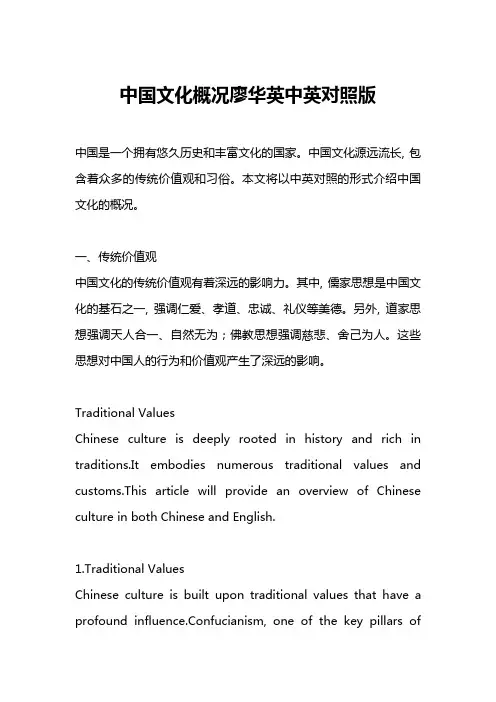
中国文化概况廖华英中英对照版中国是一个拥有悠久历史和丰富文化的国家。
中国文化源远流长, 包含着众多的传统价值观和习俗。
本文将以中英对照的形式介绍中国文化的概况。
一、传统价值观中国文化的传统价值观有着深远的影响力。
其中, 儒家思想是中国文化的基石之一, 强调仁爱、孝道、忠诚、礼仪等美德。
另外, 道家思想强调天人合一、自然无为;佛教思想强调慈悲、舍己为人。
这些思想对中国人的行为和价值观产生了深远的影响。
Traditional ValuesChinese culture is deeply rooted in history and rich in traditions.It embodies numerous traditional values and customs.This article will provide an overview of Chinese culture in both Chinese and English.1.Traditional ValuesChinese culture is built upon traditional values that have a profound influence.Confucianism, one of the key pillars ofChinese culture, emphasizes virtues such as benevolence, filial piety, loyalty, and etiquette.Taoism emphasizes the harmony between man and nature and the principle of "non-action".Buddhism emphasizes compassion and self-sacrifice.These philosophies have greatly shaped the behavior and values of the Chinese people.二、艺术与文学中国文化以其丰富多样的艺术形式而闻名。
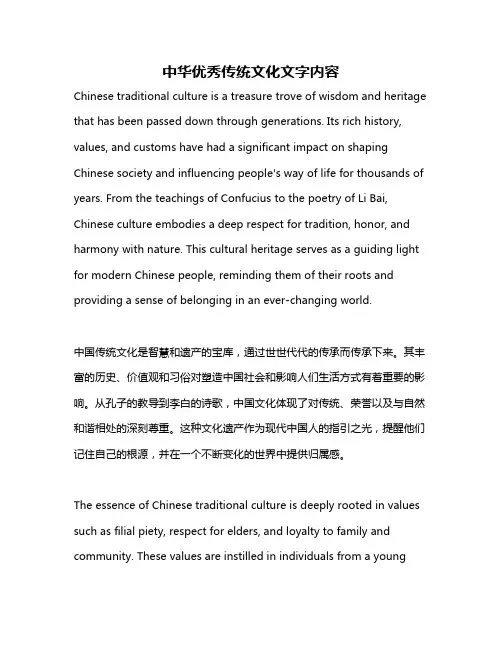
中华优秀传统文化文字内容Chinese traditional culture is a treasure trove of wisdom and heritage that has been passed down through generations. Its rich history, values, and customs have had a significant impact on shaping Chinese society and influencing people's way of life for thousands of years. From the teachings of Confucius to the poetry of Li Bai, Chinese culture embodies a deep respect for tradition, honor, and harmony with nature. This cultural heritage serves as a guiding light for modern Chinese people, reminding them of their roots and providing a sense of belonging in an ever-changing world.中国传统文化是智慧和遗产的宝库,通过世世代代的传承而传承下来。
其丰富的历史、价值观和习俗对塑造中国社会和影响人们生活方式有着重要的影响。
从孔子的教导到李白的诗歌,中国文化体现了对传统、荣誉以及与自然和谐相处的深刻尊重。
这种文化遗产作为现代中国人的指引之光,提醒他们记住自己的根源,并在一个不断变化的世界中提供归属感。
The essence of Chinese traditional culture is deeply rooted in values such as filial piety, respect for elders, and loyalty to family and community. These values are instilled in individuals from a youngage, emphasizing the importance of maintaining strong family ties and upholding moral virtues. The concept of harmony and balance, known as "Yin and Yang," is also a central theme in Chinese culture, promoting the idea of living in harmony with oneself and the world around us.中国传统文化的精髓深植于孝顺、尊敬长辈以及忠诚于家庭和社区等价值观之中。
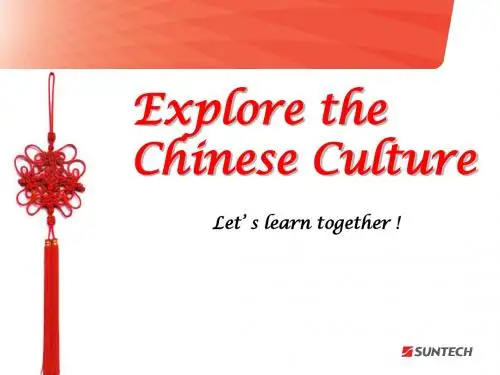
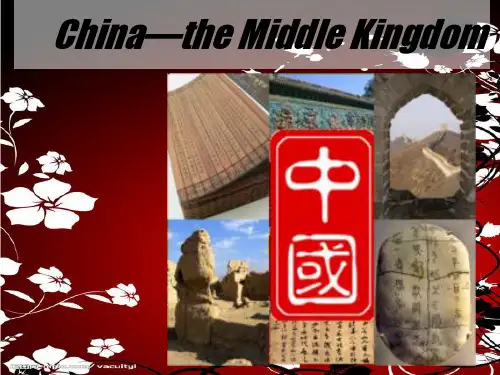
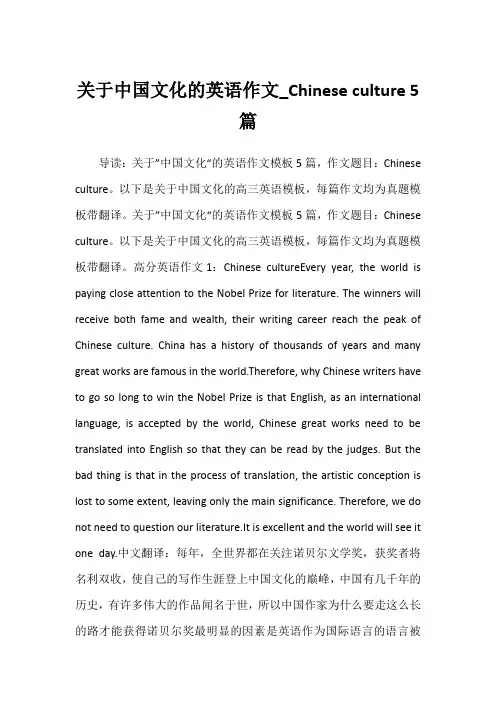
关于中国文化的英语作文_Chinese culture 5篇导读:关于”中国文化“的英语作文模板5篇,作文题目:Chinese culture。
以下是关于中国文化的高三英语模板,每篇作文均为真题模板带翻译。
关于”中国文化“的英语作文模板5篇,作文题目:Chinese culture。
以下是关于中国文化的高三英语模板,每篇作文均为真题模板带翻译。
高分英语作文1:Chinese cultureEvery year, the world is paying close attention to the Nobel Prize for literature. The winners will receive both fame and wealth, their writing career reach the peak of Chinese culture. China has a history of thousands of years and many great works are famous in the world.Therefore, why Chinese writers have to go so long to win the Nobel Prize is that English, as an international language, is accepted by the world, Chinese great works need to be translated into English so that they can be read by the judges. But the bad thing is that in the process of translation, the artistic conception is lost to some extent, leaving only the main significance. Therefore, we do not need to question our literature.It is excellent and the world will see it one day.中文翻译:每年,全世界都在关注诺贝尔文学奖,获奖者将名利双收,使自己的写作生涯登上中国文化的巅峰,中国有几千年的历史,有许多伟大的作品闻名于世,所以中国作家为什么要走这么长的路才能获得诺贝尔奖最明显的因素是英语作为国际语言的语言被世界所接受,中国的伟大作品需要翻译成英文,这样才能被评委们阅读,但不好的是,在翻译过程中,意境在某种程度上有所损失,只留下了主要的意义,所以我们不需要质疑我们的文学,它是优秀的,总有一天世界会看到它的。
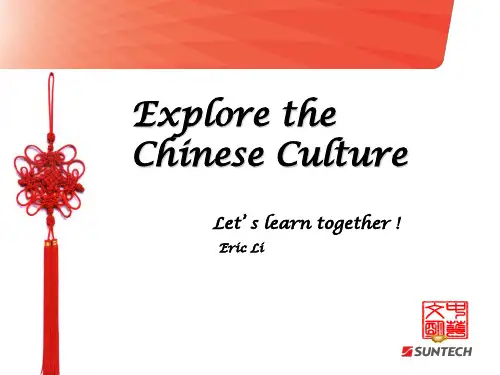
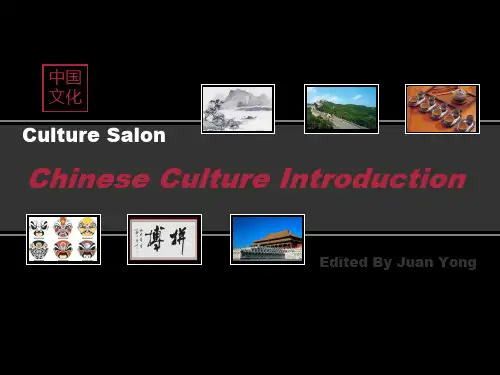
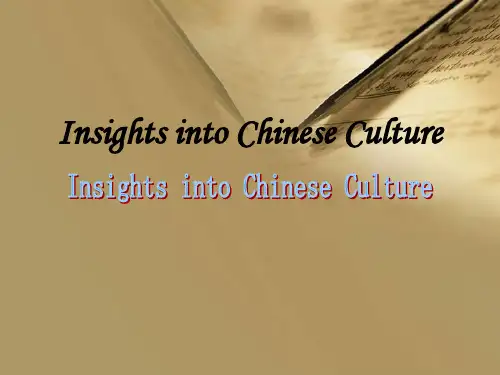

专题14---中国传统文化A(2022·四川广安·中考真题)坚定文化自信,弘扬中华优秀传统文化,做中华文明的传播者是新时代中国青少年的责任与使命。
假如你是李华,近期,一批外国朋友要到你所在的学校参观访问,你将作为学生代表向他们介绍中华优秀传统文化。
请根据下面表格中的要点提示,用英语写一篇发言稿。
要求:1.字迹工整,书写规范,不逐字翻译,包含全部要点,可适当发挥;2.文中不得出现真实的学校、班级名称;3.80词左右,开头和结尾已给出,不计入总词数;4.请将书面表达内容写在答题卡上的相应位置。
参考词汇:traditional Chinese culture中华传统文化influence影响china瓷器Beijing Opera京剧national treasure国粹technology技术Dear friends,Welcome to our school. Today, I want to share something about traditional Chinese culture with you.________________________________________________________________________________________________________________________________________________________________________________________ ____________________________________________________________________________________________ ____________________________________________________________________________________________ ____________________________________________________________________________________________ ____________________________________________________________________________________________ ____________________________________________________________________________________________ ____________________________________________________________________________________________ ________________________Thanks for your listening.【答案】例文:Dear friends,Welcome to our school. Today. I want to share something about traditional Chinese culture with you.There are many kinds of traditional Chinese culture. Some of them have a long history. They have influenced many people.Beijing Opera comes first. As one of Chinese national treasures, Beijing Opera comes from “Huiban” and it has three parts, including singing, dancing, and speaking. It’s full of famous stories, and it is loved by Chinese people of all ages.Next, let’s talk about tea. In China there are many different kinds of tea in different areas, such as green tea and black tea. It is good for our health.The last one is about china. China is the hometown of china. Our china technology is the earliest in the world, and it’s famous all over the world.Thanks for your listening.【详解】1.题干解读:该题目属于讲稿写作。
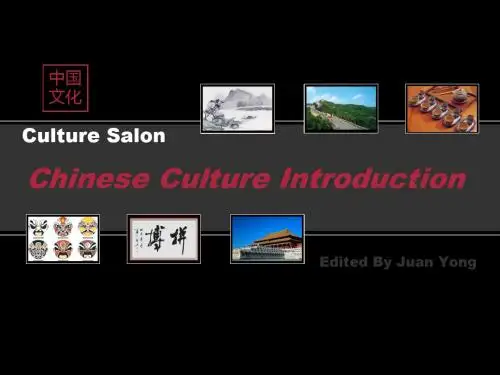
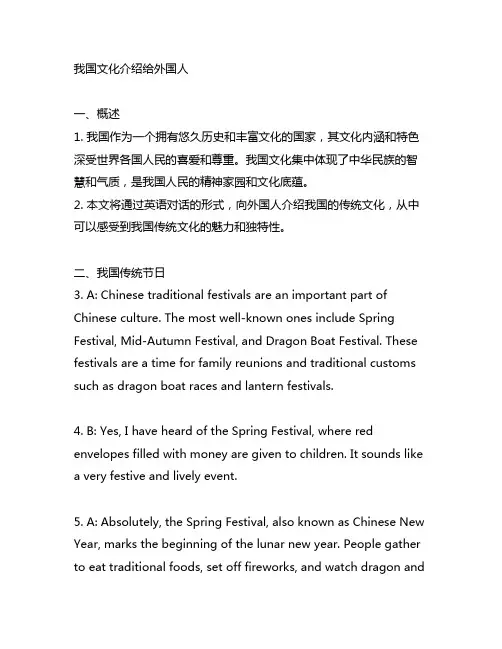
我国文化介绍给外国人一、概述1. 我国作为一个拥有悠久历史和丰富文化的国家,其文化内涵和特色深受世界各国人民的喜爱和尊重。
我国文化集中体现了中华民族的智慧和气质,是我国人民的精神家园和文化底蕴。
2. 本文将通过英语对话的形式,向外国人介绍我国的传统文化,从中可以感受到我国传统文化的魅力和独特性。
二、我国传统节日3. A: Chinese traditional festivals are an important part of Chinese culture. The most well-known ones include Spring Festival, Mid-Autumn Festival, and Dragon Boat Festival. These festivals are a time for family reunions and traditional customs such as dragon boat races and lantern festivals.4. B: Yes, I have heard of the Spring Festival, where red envelopes filled with money are given to children. It sounds like a very festive and lively event.5. A: Absolutely, the Spring Festival, also known as Chinese New Year, marks the beginning of the lunar new year. People gather to eat traditional foods, set off fireworks, and watch dragon andlion dances. It is a time for joy and celebration.6. B: I would love to experience these traditional festivals firsthand. It seems like a great way to learn more about Chinese culture and customs.三、我国传统艺术7. A: Chinese traditional art has a long history and diverse forms. Traditional Chinese p本人nting, calligraphy, and opera are all highly regarded art forms in China.8. B: I am especially interested in Chinese calligraphy. I have seen some beautiful Chinese calligraphy artworks and they are truly impressive.9. A: Chinese calligraphy is not only a form of artistic expression, but also a way to cultivate one's temperament and philosophy. Each stroke and character carries profound meanings and emotions.10. B: I can see how Chinese calligraphy requires a great deal of skill and patience. It is a truly unique art form that reflects the beauty of Chinese culture.四、我国传统饮食11. A: Chinese cuisine is famous for its variety of flavors, ingredients, and cooking techniques. Each region in China has its own distinct culinary traditions.12. B: I have tried some Chinese dishes like Peking duck and dim sum. The flavors are quite different from what I am used to, but I find them very delicious.13. A: Peking duck is a classic dish from Beijing, known for its crispy skin and tender meat. Dim sum, on the other hand, is a style of Chinese cuisine that features small, bite-sized portions of food traditionally served in small steamer baskets or on small plates.14. B: I would love to try more authentic Chinese dishes. It seems like Chinese cuisine has a lot to offer in terms of taste and variety.五、我国传统建筑15. A: Chinese traditional architecture is both functional and aesthetic. Ancient buildings like the Forbidden City and theGreat Wall are outstanding examples of traditional Chinese architecture.16. B: I have seen pictures of the Forbidden City and it looks truly magnificent. The intricate designs and elaborate decorations are truly impressive.17. A: The Forbidden City, also known as the Imperial Palace, was the Chinese imperial palace from the Ming dynasty to the end of the Qing dynasty. It is a symbol of traditional Chinese architecture and culture.18. B: I would love to visit these historical sites and learn more about Chinese traditional architecture. It would be a great way to appreciate the rich history and culture of China.六、我国传统服饰19. A: Traditional Chinese clothing, such as the qipao for women and the changshan for men, has a long history and unique style. The designs and patterns of traditional Chinese clothing reflect the essence of Chinese culture.20. B: I have seen traditional Chinese clothing in movies andthey look very elegant and sophisticated. The intricate embroidery and vibrant colors are truly captivating.21. A: Traditional Chinese clothing is not only a form of attire, but also a representation of Chinese culture and etiquette. It has evolved over thousands of years and continues to be a source of pride and identity for the Chinese people.22. B: I would love to try on traditional Chinese clothing and experience the beauty and grace of Chinese fashion. It seems like a great way to embrace the traditions and customs of China.七、我国传统文化的传承与发展23. A: Chinese traditional culture has been passed down through generations and continues to thrive in modern society. It is an integral part of the Chinese identity and has played a significant role in shaping the values and beliefs of the Chinese people.24. B: It's amazing to see how Chinese traditional culture has stood the test of time and rem本人ns relevant in today's world. It speaks to the resilience and enduring spirit of the Chinese people.25. A: Chinese traditional culture is constantly evolving and adapting to the changing times. It is a source of inspiration and pride for the Chinese people, and it continues to resonate with people around the world.26. B: I am truly fascinated by the depth and richness of Chinese traditional culture. It has given me a newfound appreciation for the heritage and legacy of China.结尾27. A: In conclusion, Chinese traditional culture is a treasure trove of history, art, and philosophy. It is a testament to the profound wisdom and creativity of the Chinese people, and it has left a lasting impact on the globalmunity.28. B: I am grateful for the opportunity to learn more about Chinese culture through this conversation. It has been an enlightening and inspiring experience.29. A: I hope that you will have the chance to visit China and immerse yourself in the beauty and splendor of Chinese traditional culture. It is a journey that is sure to leave a lastingimpression.30. B: Thank you for sharing your knowledge and insights about Chinese culture with me. I look forward to exploring more of what China has to offer in the future.以上为English dialogue的文章,约1424字。
2024年中考英语热点话题写作-中华文化之文化介绍l.(2023广东东莞统考三模)坚定文化自信,弘扬中华优秀传统文化,做中华文明的传播者是新时代中国青少年的责任与使命。
假如你是李华,近期,一批外国朋友要到你所在的学校参观访问,请用英语写一篇发言稿,向他们介绍中华优秀传统文化。
内容包括:L欢迎朋友们的到来;2.总体介绍中国传统文化种类多、历史悠久:3列举至少两个中国传统文化的例子,可以从其历史、特点、用途、或受欢迎程度等方面具体介绍。
作文要求:l.不能照抄原文;不得在作文中出现真实校名、地点和考生的真实姓名;2语句连贯,词数80个左右。
Dear friends,Thanks for your listening.2.(2023江苏无锡江苏省锡山商级中学实验学校校考三模)无锡某电台英文频道将开设China Impression栏日,面向全市中学生征集”中国印象”的英文介绍。
请你写一篇英语短文,根据以下提示词来写,向栏目组投稿。
•Introduction (location; capital;...)•A traditional festh•al (list one and describe how to celebrate it)•A famous person in history (what he/she was famous for; his/her achievements)•Your feelings about China注意事项:l征集稿须自拟,要求语句通顺、意思连贯、符合题意:2词数在100个左右,短文的首尾已在答题卡上给出,不计入总词数;3英文信中不得使用真实的个人及学校信息;4短文必须写在答题卡指定的位置。
China ImpressionChina is a great country with a long history3.(2023江苏徐州统考二模)近日,在公共场所,人们身着汉服拍照,演奏古筝、二胡等传统乐器;校园里,学生吟诵古典诗词,写毛笔字.处处彰显着中国传统文化的魅力。
ConfuciusConfucius named Qiu styled Zhongni, a great thinker and educator in the late Spring and Autumn Period, and the founder of Confucianism. Confucius instructed more than 3000 disciples and some were from poor families. Confucius gradually changed the tradition that only nobilities had the right to receive education. In his later years , Confucius compiled many literary works of ancient times, including The Book of Songs ,The Book of Documents, and The Books of Changes. His saying and behaviors were compiled in The Analects of Confucius by his disciples. His ideology has been absorbed and carried composing the essential part of Chinese traditional ideology. It was also spread into the border regions and areas building up a circle of Confucianism. UNE SCO labeled him one of the “Ten Culture Celebrities”.孔子孔子名丘字仲尼,春秋末期伟大的思想家和教育家,儒家学派创史人。